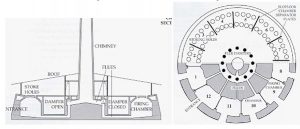Hoffmann’s Kiln and Bull’s trench kiln
Hoffmann’s Kiln and Bull’s trench kiln
Hoffmann’s Kiln
It is a continuous kiln and has a permanent roof as a result of which it can function even during rains. The first Hoffmann kilns were in the form of a great circular ring chamber, with massive walls and a large chimney at the centre, to which underground radial flues converged from the inside walls of each of the twelve chambers. The chambers were barrel arched (like a railway tunnel), and in the roof arches there were several small feed holes through which fine coal could
be fed into spaces made among the bricks to be fired. Around the outer wall or the kiln were the twelve openings for loading and unloading the individual firing chambers. These chambers were separated from each other by very large metal dampers that could be raised and lowered as the fire moved around the kiln from chamber to chamber.
With the kiln is in full operation two chambers will be open, and the other ten sealed up at the door and by the interconnecting steel dampers. If the chambers are numbered from 1 to 12, then bricks are being unloaded from 2 and loaded in 1. The damper is closed between 1 and 12, but opens between all other chambers. Air is drawn through the open door of 2 and through the bricks in 3, 4, 5, and 6, cooling them down and at the same time being heated itself.
Chamber 7 is being fired, with fuel being fed at intervals through the roof, which is immediately ignited by the hot air from 6. The products of combustion pass on to 8, 9, 10, and 11 drying and pre-heating the bricks in these chambers The chambers being loaded and unloaded move forward in sequence, and this way heat is extracted from the cooling bricks and also from the hot combustion gases.
The Bull’s trench kiln
The kiln can be made circular or elliptical in shape. It is constructed on dry land, by digging trench, 6 – 9 m wide, 2 – 2.5 m deep, and 100 – 150 m long. An alternative method is to build up the sides of the kiln with bricks, especially where drainage is a problem. Gaps are left in the outer wall for easy access to the trench during setting and drawing of bricks.The green bricks to be fired are set in rows, two to three bricks wide, with holes in between that allow feeding of coal and a sufficient flow of air through the setting (Figure 2). On top of the bricks, two layers of bricks, covered with ash or brick dust, seal the setting. A large piece of canvas, paper or metal sheet is placed vertically across the brick setting to block air from entering from the wrong side of the chimneys (Figure 3). The trench contains 200 – 300,000 bricks at a time.
Chimneys, 6 – 10 m high, made of sheet metal, are placed on top of the brick setting. They are moved around as the firing progresses and they have to be light, so that the firing crew can carry them. Wires attached to the top of the steel chimneys support them. The need for lightness and the cost of replacing the chimneys often have the effect that the height of the chimneys becomes too low. That means the exhaust temperature has to be higher in order to maintain sufficient draught and the chimneys are placed closer to the firing zone. Thereby, less heat of the exhaust gases can be reutilized. Small circular Bull’s trench kilns use only one chimney, whereas the larger elliptical kilns need two chimneys.
The firing in a Bull’s trench kiln is continuous, day and night. Green bricks are loaded and finished bricks are drawn all the time. The fuel saving is achieved by reusing part of the energy that is otherwise lost in intermittent kilns. The air for combustion is drawn through the already fired but still hot bricks. The cooling bricks transfer their heat to the combustion air, pre-heating it before it enters the firing zone. After combustion, the hot exhaust gases pass through the yet unfired bricks on their way to the chimneys. This pre-heats the bricks, so less fuel is needed to bring the bricks to the maximum temperature. Once every 24 hours the chimneys are moved forward 5 to 7 m. Daily output is 15 – 25,000 bricks.
1. Manufacturing of Bricks
2. Moulding of Bricks
3. Drying of Bricks
4. Burning of Bricks
5. Hoffmann’s kiln and Bull’s trench kiln
Hoffmann’s Kiln and Bull’s trench kiln, Hoffmann’s Kiln and Bull’s trench kiln, Hoffmann’s Kiln and Bull’s trench kiln, Hoffmann’s Kiln and Bull’s trench kiln, Hoffmann’s Kiln and Bull’s trench kiln, Hoffmann’s Kiln and Bull’s trench kiln, Hoffmann’s Kiln and Bull’s trench kiln, Hoffmann’s Kiln and Bull’s trench kiln, Hoffmann’s Kiln and Bull’s trench kiln, Hoffmann’s Kiln and Bull’s trench kiln, Hoffmann’s Kiln and Bull’s trench kiln, Hoffmann’s Kiln and Bull’s trench kiln, Hoffmann’s Kiln and Bull’s trench kiln, Hoffmann’s Kiln and Bull’s trench kiln, Hoffmann’s Kiln and Bull’s trench kiln, Hoffmann’s Kiln and Bull’s trench kiln, Hoffmann’s Kiln and Bull’s trench kiln, Hoffmann’s Kiln and Bull’s trench kiln,

i need a structure plan for hoffmann’s kiln. thanks
Share with us as well when u get one
If you got one, please share it with me.
raghuvaran.smart@gmail.com